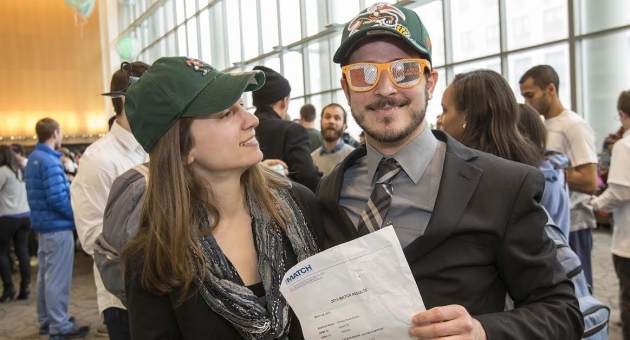Match Day at Temple’s School of Medicine

Medical student Rich Ronca, CST ’08, came prepared to Match Day 2015—he brought a baseball cap from each of the university hospitals where he might match for his residency.
Ronca was one of 205 Temple medical students taking part on March 20 in this year’s Match Day, when all fourth-year medical students in the U.S. simultaneously open a sealed envelope and learn which hospital they “matched” with for their residencies. It’s one of the most important, and most emotional, days in a student’s journey to becoming a physician.
“My first choice is Miami and my specialty will be neurology; I want to be a brain detective,” said Ronca, who is at the tail end of an 11-year Temple career—four years as an undergrad and seven in the MD/PhD program.
For the event, students gathered with family members and significant others in the lobby of the Medical Education and Research Building. They snapped photos and bit fingernails as they waited; someone even inflated a small beach ball and started bouncing it around the room to pass the time and release the tension.
With 10 seconds to go until noon, Larry Kaiser, dean of Temple University School of Medicine, president and CEO of Temple University Health System and senior executive vice president for Health Sciences at Temple, began counting down to zero. The crowd took a collective breath and then the envelopes were torn open.
One of the smiling faces belonged to Temple cardiologist James Burke, whose daughter Megan Burke matched to the Hospital of the University of Pennsylvania for an internal medicine residency. James reminisced about how he used to bring Megan to work at Temple with him when the family had no babysitting coverage.
“Some of my earliest memories were being in the control room of the Temple cath lab while my dad worked,” said Megan Burke, who is a third-generation physician. “I always loved medicine, but those experiences really sparked my interest. It gives new meaning to the Temple Made slogan.”
The matching process has been compared to rush week for fraternities and sororities: Students and hospitals first try to impress each other and then rank each other in order of preference. A computer sorts through tens of thousands of preferences and determines the matches.
As the celebration wound down, students made their way to a large map of the United States. Each grabbed a small star sticker and placed it on the city where he or she will spend the next several years in training. By the time the last person left the room, the map was a virtual galaxy of Temple stars—each ready to make a mark on the world.
- Andy Smith